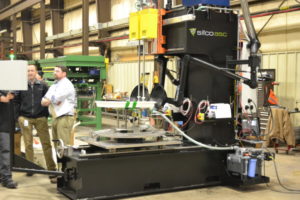By: Derek Kilgore, Mechanical Design and Project Engineer, SIFCO ASC
The short answer is yes.
The brush plating operation can be mechanized, semi-automated, or even fully automated. But first you have to ask yourself a few additional questions with your application in mind. A major consideration is practicality – does it make sense to automate your application? Can it be done? And should it be done? Typical reasons for automating a brush plating application include improving quality and consistency, increasing operator safety, and improving process throughput.
Through the mechanization of the process, the operator’s direct contact with tooling and chemicals is significantly reduced. Instead, a computer program – which can be configured by the operator – controls the volts, amps, polarity and ampere-hours required for the specific application, including preparatory and plating steps.
In practice, this removes the potential for human error and variability from the process, making the operation more reliable and consistent. By accurately controlling the level of deposits with little operator involvement, results are more consistent, driving greater levels of quality for every operation. With the introduction of data logging to the process, automated selective plating also provides full component and process traceability through constant system data monitoring.
Alongside the improvements in the operation’s results brought about by automation, the safety of operators is also elevated. Operator safety not only includes removing the operator from the chemicals, but also improved ergonomics. Reducing risk to the operator by removing them from repetitive tasks and ergonomically unfavorable positions, the capacity of skilled workers is increased to focus on other areas of the business. In turn, mechanical systems are able to replicate the application process identically every time, ensuring high levels of consistency without the need for operator intervention.
As well as improving working conditions and safety for operators, automation also leads to greater levels of efficiency and profitability. Mechanized set-ups allow for operations to run smoothly and consistently until completion, making for greater levels of productivity and the potential for reduced lead times.
Looking more closely at the operation itself, an automated approach also opens up opportunities for improving process throughput. Robotic equipment, which is capable of working around-the-clock until the completion of a particular application, also utilizes chemicals more efficiently, using only the volumes required at each stage of the selective plating process – effectively removing bottlenecks and increasing throughput.
Generally, good candidates for automation will have most or all of the following characteristics:
- Relatively simple shape (ID, OD, Flat)
- Low to medium volume of parts
- Not too many different part configurations
- Low deposit thickness
- If you meet any of the above criteria, fill out our Engineering Request Form
Once it is determined that the part is suitable for automation, then it’s a question of evaluating the current state and then understanding what the future state needs to look like. There is a significant amount of information gathering and conceptualization that needs to be done to determine options for automation.
So, in this time when industry is seeing the benefits of automating traditionally labor-intensive processes, selective plating can now be considered a state-of-the-art solution that can be semi- or fully-automated for your specific application.
To find out more, or to speak to one of the SIFCO ASC team about automated selective plating in your facility, visit www.sifcoasc.com.
If you have an application you’d like automated, please fill out our Engineering Request Form.

 Chinese (Simplified)
Chinese (Simplified)  English (UK)
English (UK)  French
French  German
German  Spanish
Spanish  Swedish
Swedish 
